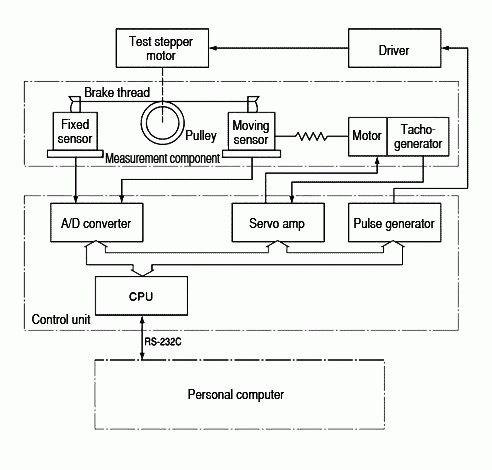SMT-type instruments for measuring stepper motor characteristics
Can you explain the operating principles of the instrument designed to measure stepper motor characteristics?

This instrument controls and senses the tensile force of a brake thread wound on the pulley attached to the test motor.
Based on the tensile force detected, the load torque is calculated as follows:
Load torque T [mN·m] is expressed as follows:
T = |F1 - F2| · (D1 + D2)/2 [mN·m]
where,
Tensile force detected by the fixed senor (left-side sensor): F1 [N]
Tensile force detected by the moving sensor (right-side sensor): F2 [N]
Pulley diameter: D1 [mm]
Brake thread diameter: D2 [mm]
Why is the Prony (winding) brake better for applying a load to a stepper motor?
Unlike AC/DC motors that rotate continuously, stepper motors are pulse-driven and rotate incrementally. Since stepper motors perform a start and step motion repeatedly with each step of the rotation, they're susceptible to the effects of inertial moments. To obtain measurements from this type of motor, we need to minimize the inertia of the load applied to the test motor. Large inertias can lead to large errors in measurements, which can be detrimental, especially for motors with very low torque. With the Prony brake system used by Sugawara in its pulse motor analyzers, the only source of inertia applied to the test motor is the extremely thin aluminum pulley attached to the shaft of the test motor. This allows accurate measurements of pull-in and pull-out torque, even with extremely small stepper motors with maximum torque values of 0.1 mN·m or less.
How is step-out detected?
When we apply a load to a rotating motor, we observe ripples in the waveforms of the torque detected during synchronized rotation. A step-out results in large vibrations in the detected torque. This large vibration in the waveform of the detected torque is identified as a step-out.
Is it possible to obtain measurements from motors for different drive systems (2 phase excitation, 1-2 phase excitation, etc.)?
Yes. This requires the appropriate drivers.